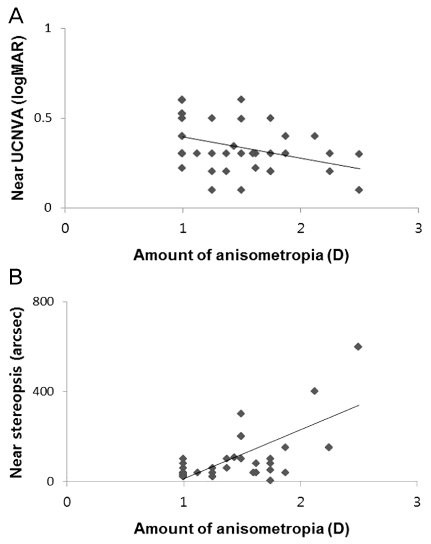J Korean Ophthalmol Soc.
2012 Nov;53(11):1621-1629.
Visual Function and Patient Satisfaction in Pseudophakic Monovision
- Affiliations
-
- 1Department of Ophthalmology, Asan Medical Center, University of Ulsan College of Medicine, Seoul, Korea. hwtchah@amc.seoul.kr
Abstract
- PURPOSE
To evaluate visual performance as well as patient satisfaction and to explore factors associated with clinical outcomes in pseudophakic monovision acquired after bilateral phacoemulsification and sequential monofocal intraocular lens (IOL) implantation.
METHODS
The present retrospective study examined patients with pseudophakic monovision. Preoperative and postoperative binocular uncorrected distant visual acuity (UCDVA), uncorrected near visual acuity (UCNVA), refractive errors and postoperative near stereopsis were measured. Postoperative measurements were obtained at least 6 months after the fellow eye surgery. Patient satisfaction and independence from glasses were evaluated using a questionnaire.
RESULTS
Preoperative and postoperative binocular UCDVA, UCNVA, and differences in spherical equivalent refractive error were statistically significant. Postoperative near stereopsis was 107.1 arcsec. Questionnaire responses showed that 71.4% of patients were less dependent on glasses and 85.7% were satisfied with the postoperative visual performance. Various designs of monovision, such as crossed monovision or customized minimonovision with moderate myopic defocus showed the same level of patient satisfaction. Patients who were older than 60 years or had poorer preoperative binocular UCDVA showed higher satisfaction.
CONCLUSIONS
Pseudophakic monovision is an effective approach for managing loss of accommodation after cataract surgery, especially in patients older than 60 years.
Keyword
MeSH Terms
Figure
Reference
-
1. McDonnell PJ, Lee P, Spritzer K, et al. Associations of presbyopia with vision-targeted health-related quality of life. Arch Ophthalmol. 2003. 121:1577–1581.2. Gobbi PG, Fasce F, Bozza S, et al. Far and near visual acuity with multifocal intraocular lenses in an optomechanical eye model withimaging capability. J Cataract Refract Surg. 2007. 33:1082–1094.3. Finkelman YM, Ng JQ, Barrett GD. Patient satisfaction and visual function after pseudophakic monovision. J Cataract Refract Surg. 2009. 35:998–1002.4. Olson RJ. Presbyopia correcting intraocular lenses: what do I do? Am J Ophthalmol. 2008. 145:593–594.5. Leaming DV. Practice styles and preferences of ASCRS members--2003 survey. J Cataract Refract Surg. 2004. 30:892–900.6. Pick ZS, Leaming DV, Elder MJ. The fourth New Zealand cataract and refractivesurgery survey: 2007. Clin Experiment Ophthalmol. 2008. 36:604–619.7. Greenbaum S. Cost-benefit analysis of multifocal IOLs versus monovision pseudophakia. J Cataract Refract Surg. 2009. 35:614.8. Maxwell WA, Waycaster CR, D'Souza AO, et al. A United States cost-benefit comparison of an apodized, diffractive, presbyopia-correcting, multifocal intraocular lens and a conventional monofocal lens. J Cataract Refract Surg. 2008. 34:1855–1861.9. Pepin SM. Neuroadaptation of presbyopia-correcting intraocular lenses. Curr Opin Ophthalmol. 2008. 19:10–12.10. Johannsdottir KR, Stelmach LB. Monovision: a review of the scientific literature. Optom Vis Sci. 2001. 78:646–651.11. Erickson P, Schor C. Visual function with presbyopic contact lens correction. Optom Vis Sci. 1990. 67:22–28.12. Evans BJ. Monovision: a review. Ophthalmic Physiol Opt. 2007. 27:417–439.13. Farid M, Steinert RF. Patient selection for monovision laser refractive surgery. Curr Opin Ophthalmol. 2009. 20:251–254.14. Wright KW, Guemes A, Kapadia MS, Wilson SE. Binocularfunction and patient satisfaction after monovision induced by myopic photorefractive keratectomy. J Cataract Refract Surg. 1999. 25:177–182.15. Goldberg DB. Laser in situ keratomileusis monovision. J Cataract Refract Surg. 2001. 27:1449–1455.16. Boerner CF, Thrasher BH. Results of monovision correction in bilateral pseudophakes. J Am Intraocul Implant Soc. 1984. 10:49–50.17. Greenbaum S. Monovision pseudophakia. J Cataract Refract Surg. 2002. 28:1439–1443.18. Ito M, Shimizu K, Amano R, Handa T. Assessment of visual performance in pseudophakic monovision. J Cataract Refract Surg. 2009. 35:710–714.19. Hayashi K, Yoshida M, Manabe S, Hayashi H. Optimal amount of anisometropia for pseudophakic monovision. J Refract Surg. 2011. 27:332–338.20. Handa T, Mukuno K, Uozato H, et al. Ocular dominance and patient satisfaction after monovision induced by intraocular lens implantation. J Cataract Refract Surg. 2004. 30:769–774.21. Nitta M, Shimizu K, Niida T. [The influence of ocular dominance on monovision--the influence of strength of ocular dominance on visual functions]. Nihon Ganka Gakkai Zasshi. 2007. 111:441–446.22. Jain S, Arora I, Azar DT. Success of monovision in presbyopes: review of the literature and potential applications to refractive surgery. Surv Ophthalmol. 1996. 40:491–499.23. Ito M, Shimizu K. Reading ability with pseudophakic monovision and with refractive multifocal intraocular lenses: comparative study. J Cataract Refract Surg. 2009. 35:1501–1504.24. Jain S, Ou R, Azar DT. Monovision outcomes in presbyopic individuals after refractive surgery. Ophthalmology. 2001. 108:1430–1433.25. Lee HY, Her J. Clinical evaluation of monovision after cataract surgery. J Korean Ophthalmol Soc. 2008. 49:1437–1442.26. Fawcett SL, Herman WK, Alfieri CD, et al. Stereoacuity and foveal fusion in adults with long-standing surgical monovision. J AAPOS. 2001. 5:342–347.27. Harris MG, Classé JG. Clinicolegal considerations of monovision. J Am Optom Assoc. 1988. 59:491–495.28. Stanojcic N, Wilkins M, Bunce C, Ionides A. Visual fields in patients with multifocal intraocular lens implants and monovision: an exploratory study. Eye (Lond). 2010. 24:1645–1651.29. Kawamorita T, Uozato H, Handa T, et al. Effect of pupil size on visual acuity in a laboratory model of pseudophakic monovision. J Refract Surg. 2010. 26:378–380.30. Chen M, Atebara NH, Chen TT. A comparison of a monofocal Acrysoft IOL using the "blended monovision" formula with the multifocal array IOL for glasses independence after cataract surgery. Ann Ophthalmol (Skokie). 2007. 39:237–240.31. Chayet A, Sandstedt C, Chang S, et al. Correction of myopia after cataract surgery with a light-adjustable lens. Ophthalmology. 2009. 116:1432–1435.32. Mayer S, Böhm T, Häberle H, et al. [Combined implantation of monofocal and multifocal intraocular lenses for presbyopia correction in cataract patients]. Klin Monbl Augenheilkd. 2008. 225:812–817.33. Iida Y, Shimizu K, Ito M. Pseudophakic monovision using monofocal and multifocal intraocular lenses: hybrid monovision. J Cataract Refract Surg. 2011. 37:2001–2005.
- Full Text Links
- Actions
-
Cited
- CITED
-
- Close
- Share
- Similar articles
-
- Clinical Results of Pseudophakic Monovision 1 Year after Cataract Surgery
- Comparison of Clinical Outcomes between Laser Blended Vision and Monovision Laser Refractive Surgery for Presbyopia
- Clinical Study of Changes in Eye Dominance after Pseudophakic Conventional Monovision
- Long-Term Results of LASIK for Presbyopia Correction in Myopic Patients Using Aspheric Micro-Monovision
- LASIK for Myopia with Presbyopia Using the Aspheric Micro-Monovision Technique


